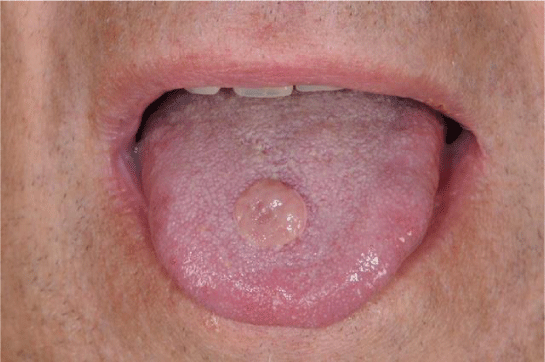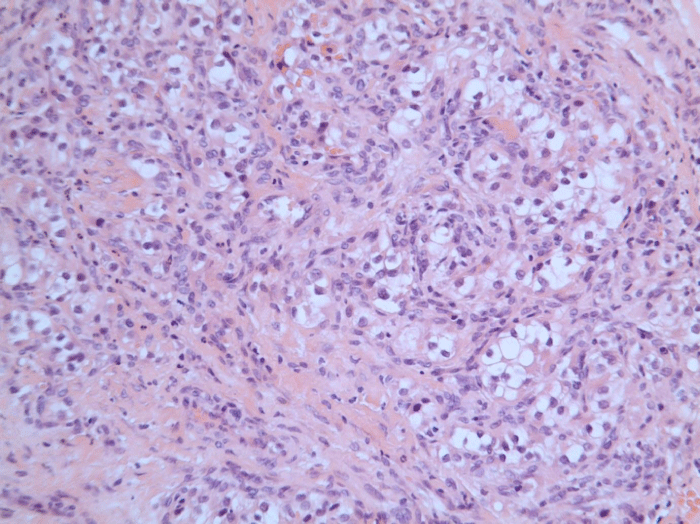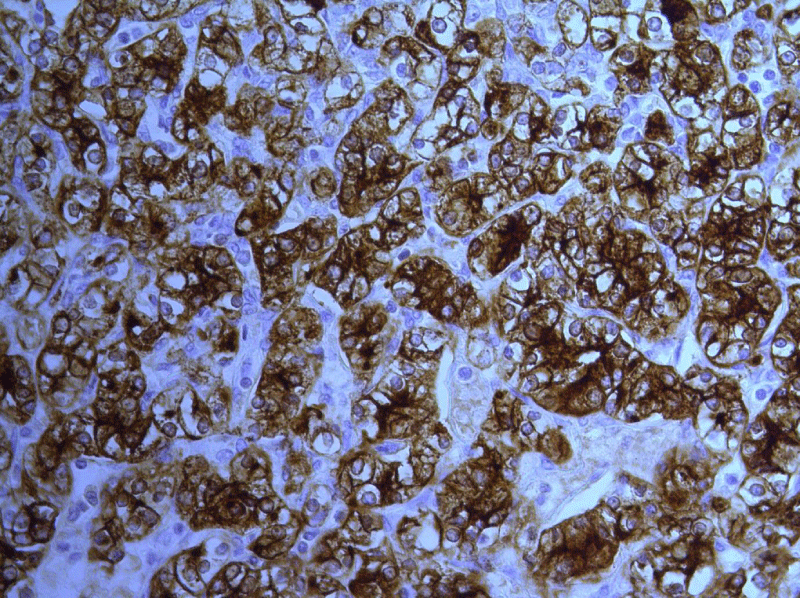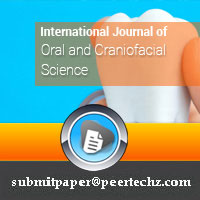International Journal of Oral and Craniofacial Science
Recurrent oral metastatic lesion of renal cell carcinoma - A case report
A Kizaekka1*, P Chengot2 and CJ Mannion3
2Consultant Pathologist, Leeds Teaching Hospitals, NHS Trust, United Kingdom
3Clinical Associate Professor, Leeds Teaching Hospitals, NHS trust, United Kingdom
Cite this as
Kizaekka A, Chengot P, Mannion CJ (2019) Recurrent oral metastatic lesion of renal cell carcinoma - A case report. Int J Oral Craniofac Sci 5(2): 024-026. DOI: 10.17352/2455-4634.000041Introduction
Metastatic lesions to the oral cavity are extremely rare, accounting for approximately 1% of all malignant oral tumours [1]. Although an uncommon tumour, Renal Cell Carcinoma (RCC) is the most common type of renal tumour presenting in adults, originating from the lining of the proximal convoluted tubule. It is responsible for approximately 90%–95% of all cases in kidney cancer [1].
It is known to metastasise 20% to 25% most frequently to the brain and liver. Renal Cell Carcinoma can also metastasise to the oral cavity, although rarely (around 1%).
The following case highlights the oral metastasis of a patient with renal cell carcinoma who had been treated and disease free for greater than 15 years. This patient also presented with 2 separate but similar metastatic lesions to the oral cavity.
More than 50% of patient with early stage of RCC are treated succefully, but stage 1V disease outcome is very poor. So detection and early treatment is very important.
Case Presentation
A 77-year-old gentleman was referred with a five week history of a traumatic lesion on the dorsum of his tongue. He was concerned with the relative speed of its growth and noted that it had appeared after he traumatised his tongue with a thermal injury after eating hot food and causing a ‘burn’ to his tongue.
His medical history noted a previously history of renal cell carcinoma and treated with a radical nephrectomy in 2002. He was under clinical review for 5 years for which he was disease free. His medication list included aspirin, losartan, simvastatin and cetirizine.
He was referred to the Maxillofacial department in Leeds dental institute for assessment and evaluation (Figure 1).
Oral examination showed 6×5×4mm pedunculated lesion on the dorsum of tongue. The remaining oral cavity was otherwise normal with no associated cervical lymphadenopathy. The lesion was non-tender, soft and did not bleed on touch.
Differential diagnosis was a possible pyogenic granuloma, a ‘benign, acquired vascular lesion of the skin and mucous membranes’ [2].
Excisional biopsy of the oral lesion was performed under local anaesthesia. The histology report indicated ‘metastatic renal cell carcinoma’.
The patient was referred to the renal MDT for discussion and an urgent CT scan of head and thorax, abdomen and pelvis was undertaken.
Metastatic Renal Cell Carcinoma was identified to the oral cavity. The CT scans also indicated 2 large metastatic lesions to the pulmonary cavity, an 18 mm metastatic nodule noted to the left atrium and hepatic flexure, together with a small solitary liver metastasis.
The previous nephrectomy site ‘bed’ was clear with the right kidney appearing normal. No destructive bone abnormality was spotted [3].
The gentleman was commenced on appropriate chemotherapy treatment and underwent further CT and MRI scans following this to assess response to treatment. These were reported as being clear of disease with no evidence of metastatic disease (Figures 2,3).
Immunochemical staining confirming the diagnosis of renal cell carcinoma.
The subtype of renal cell carcinoma was “metastatic clear cell renal cell carcinoma”.
The features were those of metastatic clear cell renal cell carcinoma. He had continued clinic review with medical oncologists and he continued to do well. Unfortunately the patient experienced complications with the medical oncology treatment which resulted in him stopping his treatment and agreeing to a package of supportive care.
He was once again seen in our Maxillofacial Department in November 2017 having developed a further metastatic lesion to his tongue within 7 months of his original diagnosis. He underwent further excisional biopsy of this lesion which again confirmed metastatic RCC.
He was last seen 3 months following this local excision and there were no further signs of any oral lesions. He was then discharged from our clinic.
Discussion
Renal tumours are among the 10 most frequently occurring cancers in western communities. Globally only 270000 cases of kidney cancer are diagnosed yearly and 116000 people die from the disease.
Metastasis of cancer to the mouth cavity and particularly to the tongue, is extremely rare. In a review of 6881 cancers, 0.2% incidence of lingual metastasis was observed by Zegarelli [5]. The rarity of lingual metastasis is possibly explained in terms of the inhospitable nature of the site. The tongue is subject to mechanical, chemical and thermal variation, all of which function to inhibit colonization. Further, it is now recognized that skeletal muscle secretes several factors that have anti-cancer activity including TNF-α, TGF-β, lymphocyte infiltrating factor, interferon, lactic acid, proteolytic enzymes and adenosine receptor agonists [6]. Cancers which are commonly known to metastasize to the tongue include Kidney (28%), Lung (28%) Skin melanoma (11%) and Breast (9%) [7].
Renal Cell Carcinoma (RCC, renal adenocarcinoma) accounts for 3% of all adult malignancies and is the most common renal tumour.
Approximately 90% of all kidney cancers are renal cell carcinomas (RCC). Upon the diagnosis of RCC, curative surgery is an option for those with early stage localized disease. Localised disease may undergo early haematogenous dissemination leading to metastasis. Sites of early metastases include the lungs, lymph nodes, liver, bone, and brain. RCC can also metastasize to the adrenal glands, the contralateral kidney [2].
Individuals with advanced disease face high rates of morbidity and mortality with a median 5-year survival rate of 53% for stage III disease and 8% for metastatic disease.
This patient had initially been surgically treated for renal cell carcinoma with a radical nephrectomy in 2002 and therefore had been disease free for 15 years.
As is noted here, the patient subsequently presented to our clinic with an oral lesion appearing of presumed traumatic origin.
Following excision and histopathological diagnosis, this lesion was identified as an oral cavity metastasis of renal cell carcinoma.
Thus, patients who have previously suffered from renal cell carcinoma need to be should be made aware of the possibility of its metastatic potential and spread, including to the oral cavity.
Similarly, metastatic lesions should always be considered in any rapidly growing lesion appearing in the oral cavity.
Furthermore, this case identifies that if metastasis occurs to the oral cavity the possibility of widespread metastatic disease should be thoroughly investigated in an appropriate multidisciplinary setting [8].
Oral malignant metastases are a relatively rare finding considering the incidence of metastatic tumours in the body. They account for less than one percent of all metastatic malignancies, with preferable regions of spread involving the spine, pelvis, skull or ribs. On the face it is the nose and paranasal sinuses are most commonly affected, followed by the oral cavity.
A histological analysis of any biopsy specimen following a thorough history, clinical examination and appropriate investigations is paramount to provide a definitive tissue diagnosis. This clinical case also highlights the importance of a clear and concise past medical history.
Conclusion
Our case identifies how Renal Cell Carcinoma, in rare cases, can metastasize to the oral cavity. This patient experienced metastatic disease to the oral cavity on two occasions when he had been disease free for over 15 years. It is important to undertake a thorough medical and general history with the biopsy of any suspicious lesions. The possibility of metastasis and widespread disseminated disease should always be considered.
We would like to thank Dr. Preetha Chengot, Consultant Histopathologist, Leeds General Infirmary for providing the histopathological slides and report included in this article. Ethical approval was obtained and the patient has consented to this case report.
- Campbell SC, Novick AC, Bukowski RM (2007) Renal tumors. In: Wein AJ, editor. Campbell-Walsh Urology. Philadelphia, PA: Saunders Elsevier 2: 1582-1632.
- Kulungowski AM, Fishman SJ (2012) Vasular anomalies. In: Arnold G Coran, editor. Pediatric Surgery 7th ed, Mosby 1613-1630.
- Reproduction of the CT scan report.
- The microscopic description presented here reproduces the exact description as submitted to us by Dr. Preetha Chengot, Consultant Histopathologist, Leeds General Infirmary.
- Zegarelli DJ, Tsukada Y, Pickren JW, Greene GW (1973) Metastatic tumor to the tongue: Report of 12 cases. Oral Surg Oral Med Oral Pathol 35: 202-211. Link: http://bit.ly/2krTHtz
- Bar-Yehuda S, Barer F, Volfsson L, Fishman P (2001) Resistance of muscle to tumor metastases: A role for a3 adenosine receptor agonists. Neoplasia 3: 125-131. Link: http://bit.ly/2krTt5H
- HassonaY, Hughes C, Prime S (2011) Metastatic tumors of the tongue. Oral Oncol 47: 308-311.
- Van der Waal RIF, Butler J, Van der Waal I (2003) Oral metastases: Report of 24 cases. Br J Oral Maxillofac Surg 41:3-6. Link: http://bit.ly/2k9tz6m
Article Alerts
Subscribe to our articles alerts and stay tuned.
 This work is licensed under a Creative Commons Attribution 4.0 International License.
This work is licensed under a Creative Commons Attribution 4.0 International License.




 Save to Mendeley
Save to Mendeley
